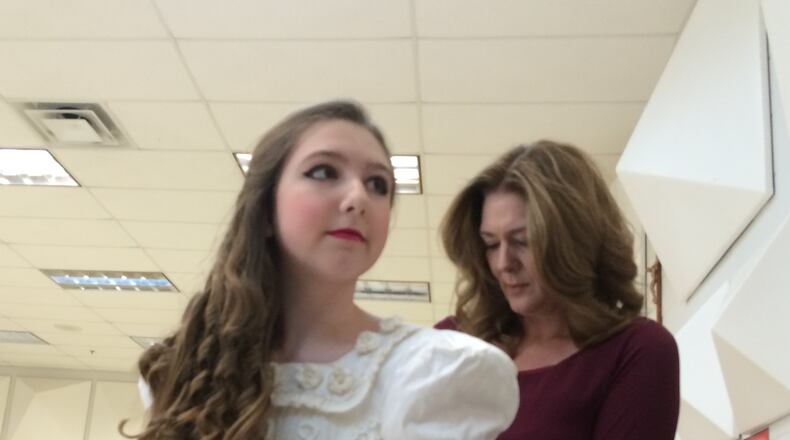Claire Houlihan steps onto the stage and into the role of Clara.
It is Christmas Eve, and Drosselmeyer has arrived with his marvelous gift, the Nutcracker. As Clara, Claire is poised and elegant, her movements as graceful as flower petals floating on the wind.
Credit: Jennifer Brett
Credit: Jennifer Brett
In the darkened audience, her mom beams.
"I love that she got the role," Jennifer Houlihan whispers. "It does mean so much to her."
Claire is 13, so this year was her last shot at the signature part. She tried out last year and didn’t get the role.
“Three of her friends did. She was genuinely happy for them,” Houlihan says. She gets a little emotional, as any proud mom would, watching her daughter dance center stage. But there is another, less obvious reason why this performance is so important.
“I know what she’s having to endure,” Houlihan says. “She would never let on. She never talks about it. I don’t even think anyone knows.”
A coveted role
Claire first saw “The Nutcracker” when she about 4. She was immediately transfixed.
Credit: Jennifer Brett
Credit: Jennifer Brett
"When I was little, I was constantly dancing and I just loved it," said Claire, a student at the Peachtree City School of Dance. Her first "Nutcracker" roles in years past were as party children, and she's thrilled to be one of the company's three Claras this year.
“I feel very special. I really love it,” she said. “The audience sees the ballet through your eyes. You have to be very expressive.”
A home-schooled eighth-grader, Claire practices for about 10 to 12 hours a week, and she joined her fellow dance students for a dress rehearsal on Saturday at Our Lady of Mercy Catholic High School in Fayetteville, where performances will be held.
Credit: Jennifer Brett
Credit: Jennifer Brett
She and her mom arrived early, excited to visit with the other dancers and their families. They helped one girl with her hair and another with her costume, happily chatting while Claire laced her pointe shoes and warmed up.
What they did not talk about, the thing that most people probably wouldn’t guess, is that Claire’s spine has begun to curve sideways. She must wear a brace every night when she sleeps, and beginning in January, she’ll have to wear it during the day as well.
Claire was about 12 when she was diagnosed with scoliosis.
“I was a little upset,” she said. “I wasn’t looking forward to sleeping in a brace.”
They both had a key question for the doctors, her mom recalled: “Can she dance?”
Credit: Jennifer Brett
Credit: Jennifer Brett
‘Like wearing a body cast’
In vastly oversimplified terms, vertebrae fit together sort of like a graduated stack of building blocks, with holes in the middle. They serve as a set of the body's own bodyguards, protecting the spinal cord. Scoliosis is a sideways curvature of the spine, meaning those building blocks no longer stack properly. The majority of cases are idiopathic, meaning there's no known cause, said Mary Lou Oliver, scoliosis screening program coordinator at Children's Healthcare of Atlanta.
National Scoliosis Foundation data show it affects 2 to 3 percent of the population, or an estimated 6 million to 9 million people in the United States. The primary age of onset is between 10 and 15. It occurs equally in both genders, but girls are more likely to develop curvatures requiring treatment, according to the foundation.
“We find it in all body types,” she said. “Scoliosis happens in otherwise very healthy children. There are no outward symptoms. There’s no pain associated with it. This is why children need to be screened from ages 10 to 15.”
Credit: Jennifer Brett
Credit: Jennifer Brett
Bracing at this age is the recommended treatment and it’s very effective; young scoliosis patients who adhere to their prescribed regimens have a 75 percent chance of not needing surgery later, Oliver said. Untreated, the condition can eventually cause back pain or complications like heart or lung problems, she said.
“Bracing really does work,” she said. “It’s not an easy process. Wearing a brace on the trunk of your body is difficult.”
She likens it to wearing braces on your teeth, an unpleasant experience far more people go through as adolescents.
Houlihan, who urges parents to seek screening and act as proactive advocates for their kids, knows all too well what her daughter is in for. She was a little younger than Claire is now when she was diagnosed herself. She had to wear a brace for several years, for up to 23 hours a day.
“It was pretty rough,” Houlihan recalled. “People were pretty mean. They teased me and picked on me a lot. I was sort of ostracized.”
With Claire, Houlihan isn’t as worried about bullying as she is about the brace itself.
“You’re hot, you can’t get comfortable at night,” she said. “It’s basically like wearing a body cast. It’s a pain.”
Claire doesn’t complain and doesn’t feel sorry for herself, her mom noted: “She’s an upbeat kiddo.”
Here's a video of Claire from Saturday's dress rehearsal:
Dedication to dance and dancers
Peachtree City School of Dance director Kathleen Senger is impressed with Claire both on and off the dance floor.
“She’s a wonderful mentor to our younger dancers,” she said. “She’s very dedicated to her art. She gives 100 percent.”
Credit: Jennifer Brett
Credit: Jennifer Brett
Claire will be able to continue dancing after January. She can take off her brace while practicing and her doctor says the flexibility and physical activity associated with dancing will actually help her back.
Her advice to other dancers facing challenges of any nature seems applicable to anyone: “Work hard in your dance classes. Don’t compare yourself to others. There’s always going to be a dancer better than you. Focus on making yourself a better dancer. Try to be a better dancer than you were yesterday.”
Credit: Jennifer Brett
Credit: Jennifer Brett
About the Author
Keep Reading
The Latest
Featured










